If you are looking to build your leg strength without using weights, or maybe just get a solid leg workout in while at home, a calisthenics leg workout will do the trick.
A solid calisthenics leg workout uses body weight to build muscle and improve your leg strength, balance, and help you build your core. Mixing calisthenics with your strength training is a great way to keep the muscles guessing and really sculpt your physique.
In this guide, we will cover key exercises, benefits, and workout structuring tips to help you train your legs effectively, anywhere.
What is Calisthenics Leg Training?
A calisthenics leg workout means using just your body weight to workout and build your leg muscles. Unlike traditional weight lifting where you may use dumbbells, barbells, or machines, calisthenics just uses body weight for resistance, making it really adaptable and accessible for anyone, anywhere.
Whether you’re at home, in a park, or on the go, you can effectively train your legs without the need for the heavy equipment. Many think calisthenics can only really sculpt your upper body, but calisthenic leg workouts can really pack a punch too.
Calisthenic training enhances muscle strength, improves endurance, flexibility, and overall functional fitness. Repeated movements lead to significant leg development, creating powerful, toned legs comparable to those built with traditional weights.
Calisthenics leg workouts also allow you to adjust the intensity by adding resistance (i.e. bands) or altering body positions to meet your own training goals.
The Benefits of Calisthenics Leg Workouts
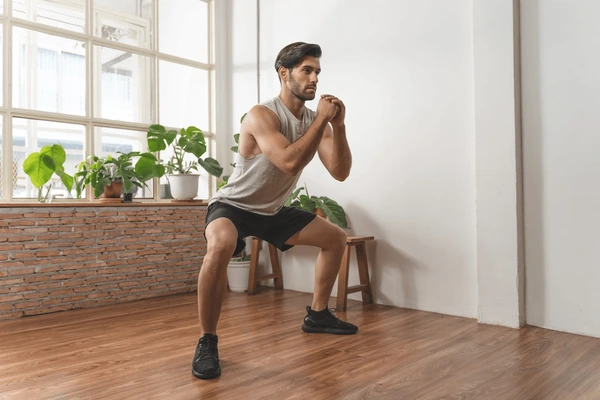
Calisthenics leg workouts come with a bunch of benefits that go beyond just building muscle.
Focusing on various leg muscles through a range of exercises improves:
- Strength
- Endurance
- Mobility
- Overall functional fitness
These workouts are designed to engage multiple muscle groups, which will help you develop your legs in a balanced manner, and will help you improve functional strength (strength for daily activities, like bringing in the groceries).
One of the standout advantages of calisthenics is its ability to be performed almost anywhere, making it a highly accessible form of exercise. This flexibility means you can maintain a consistent workout routine regardless of your location. I know that this was a huge benefit for me when I was traveling every week in Europe. I could just bang out a bodyweight workout in my hotel room and it was a great way to break a sweat.
Additionally, the use of body weight for resistance allows for a variety of exercises that target different muscle groups, for a comprehensive lower body training routine. There are bodyweight leg workouts for the quads, hamstrings, glutes, etc. so you won’t miss any muscle groups.
Regularly doing a calisthenics leg workout will enhance your mobility and balance, leading to better movement patterns and avoiding imbalances. The mobility and balance gains will also directly translate to better strength training sessions.
For a deeper dive into how bodyweight workouts stack up against workouts with weights, read out article on Bodyweight vs. Free Weights Workouts.
The Best Calisthenics Leg Exercises
Mastering some of the fundamental exercises is a great way to start your calisthenics leg training. Key movements such as Bodyweight Squats, Bulgarian Split Squats, and Jump Squats form the backbone of an effective calisthenics leg workout.
These exercises will target all the different leg muscles, providing a well-rounded approach to building strength and endurance.
Bodyweight Squats

Bodyweight squats are the spine of any bodyweight leg workout, and are simply the best bodyweight workout you can do to build overall leg strength and muscle. This foundational exercise develops lower body strength and also improves overall mobility.
Squats are essential for training lower body muscles effectively and are a great starting point for anyone new to calisthenics leg workouts. Proper squat technique will also lay the foundation for other exercises, help prevent injuries, and improve balance. For more details, read our article on proper squat form.
How to:
- Stand with your feet shoulder-width apart, toes slightly turned out.
- Bend your knees and push your hips back as if sitting in a chair.
- Lower your body until your thighs are at least parallel to the ground.
- Press through your heels to stand back up to the starting position.
Bulgarian Split Squats
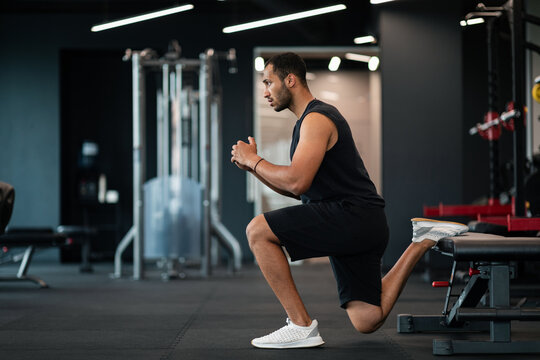
Bulgarian Split Squats are a strong exercise that isolates each leg. This will help you get rid of muscle imbalances (i.e. your right leg being stronger than your left), and improve your flexibility and balance.
This exercise provides a greater challenge and takes a bit more focus than most leg exercises. Since each leg is worked independently, you will really feel the movement in the muscles, helping with your mind-muscle connection.
How to:
- Stand a couple of feet from a bench or step, and place your rear foot on it.
- Sink down into a squat, so your front thigh is almost parallel to the floor.
- Drive through your front heel to return to the starting position, keeping your chest up and core tight throughout the movement.
Lunges
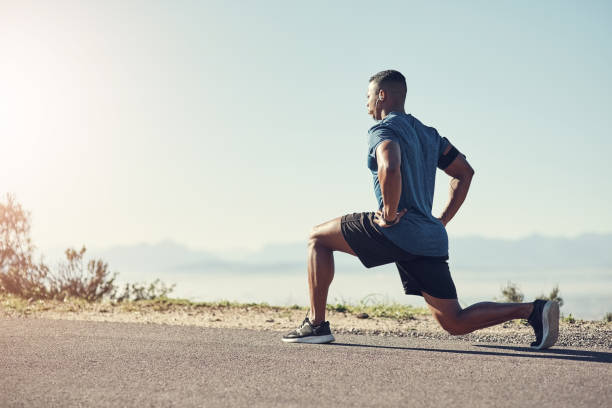
Lunges are another fundamental exercise for lower body development, targeting the quadriceps, hamstrings, and glutes. The dynamic movement helps improve balance, coordination, and unilateral (one-sided) strength.
Lunges are also a great dynamic movement that can help warm-up the leg muscles, and are a great way to break a sweat and get the heart rate moving. Lunges are fundamental to endurance athletes as well.
How to perform a Lunge:
- Stand with feet together.
- Take a large step forward with one leg.
- Lower your hips so that your front thigh becomes parallel to the floor and your back knee is close to touching it.
- Push off your front foot to return to the starting position, and repeat on the other side.
Step-Ups
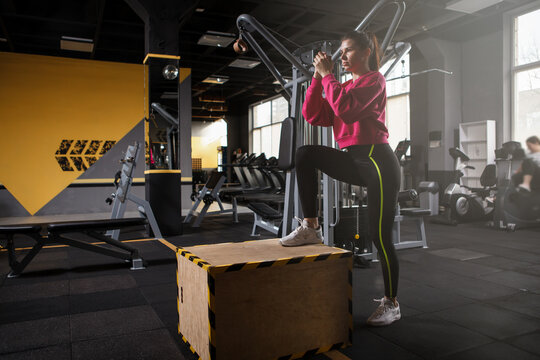
Step-ups are a versatile lower body exercise that not only strengthens the legs but helps build your core. Step-ups are also an amazing tool for building balance and symmetry in your lower body.
By stepping onto a raised platform, you effectively engage the thigh and hip muscles, with an emphasis on the glutes and quadriceps of the leading leg. This is also a great workout for athletes looking to work on being explosive.
How to perform a Step-Up:
- Stand in front of a bench or step.
- Place one foot on the step, pushing down through your heel to lift your body up onto the platform.
- Step back down with the same leg and repeat, then switch legs.
Calf Raises

Calf Raises are a targeted exercise specifically aimed at strengthening and defining the calf muscles, which play a significant role in walking and running. This movement focuses on the gastrocnemius and soleus muscles in the calves, enhancing their size and endurance.
How to:
- Stand upright with your feet hip-width apart; you can perform this on a flat surface or on the edge of a step for increased range of motion.
- If on a flat surface, simply rise up onto your tiptoes, engaging the calf muscles as you lift.
- If using a step, let your heels hang off the edge slightly.
- Push through the balls of your feet to raise your heel as high as possible, squeezing your calf muscles at the top of the movement.
- Slowly lower your heels back down below the step level (if applicable) or to the floor, stretching the calf muscles.
- Repeat the movement for the desired number of repetitions.
Calf raises are simple yet effective for improving the muscularity of the lower legs and can be performed anywhere, making them a versatile addition to any fitness routine.
Single Leg Bodyweight RDLs
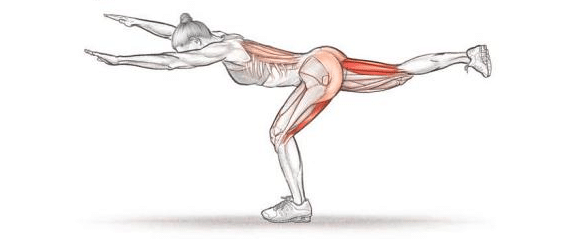
Simply put, the best hamstring exercise for a calisthenics leg workout is the Single Leg Bodyweight Romanian Deadlift (RDL). Single Leg RDLs focus on the posterior chain, including the hamstrings, glutes, and lower back.
The Single Leg RDL also helps you build balance, unilateral strength, and stability, as it challenges your ability to maintain proper posture while one leg is in motion. I love RDLs because you can really feel the tension put on your hamstrings as you lower yourself to the ground. Another great exercise for the mind-muscle connection.
How to perform a Single Leg Bodyweight RDL:
- Stand on one leg, with the other leg slightly bent behind you for balance.
- Hinge at the hips to lower your torso towards the ground, extending your free leg behind you.
- Maintain a slight bend in the standing leg without letting your back round.
- Squeeze your glutes to return to the starting position and repeat on the opposite side.
These exercises all put together provide a well-rounded approach to strengthening the lower body, building functional movements, and making sure you are strengthening your leg muscles in a balanced manner.
Advanced Calisthenics Leg Exercises
Once you’ve mastered the essential exercises, it’s time to challenge yourself with advanced calisthenics leg exercises. These movements are designed to push your limits, improve strength and muscle growth, and keep your workouts engaging and effective.
Let’s get into some of the most effective advanced exercises.
Jump Squats
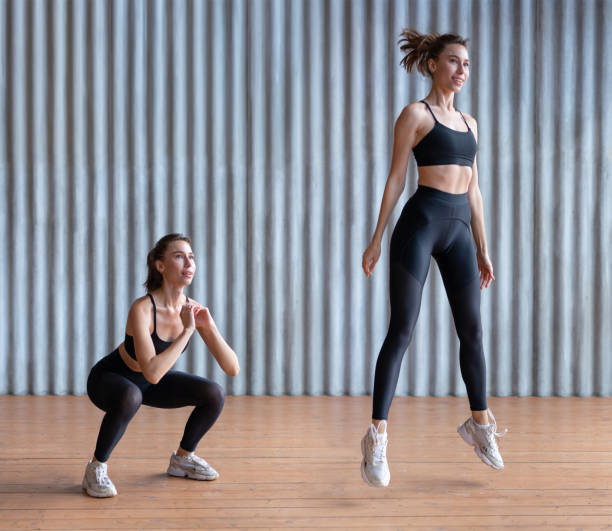
Jump squats are a dynamic, high-intensity exercise designed to enhance explosive power and endurance. This plyometric exercise not only improves leg strength but also boosts cardiovascular fitness and overall stamina.
These are a staple for athletes looking to build explosiveness and get those fast-twitch muscle fibers going. This is great for any high-intensity workout where you want to get the heart rate going and the blood pumping.
How to:
- Start in a squat position with your feet shoulder-width apart.
- Lower your body into a deep squat.
- Explode up from the bottom of the squat, propelling yourself off the ground.
- Land softly on your feet and go directly into the next squat.
Walking Lunges

Walking lunges add a dynamic component to the traditional lunge, increasing the challenge to your balance and coordination.
This exercise not only strengthens the legs but also engages the core and improves overall stability as you move forward with each step. Walking lunges are a great way to get your leg workout started, as they’ll get your legs and heart primed for a workout since they include lots of movement.
How to perform Walking Lunges:
- Start with your feet together.
- Step forward into a lunge position, lowering your back knee towards the ground.
- Press through your front heel to lift your back leg and step forward into another lunge.
- Continue moving forward, alternating legs with each step.
Pistol Squats
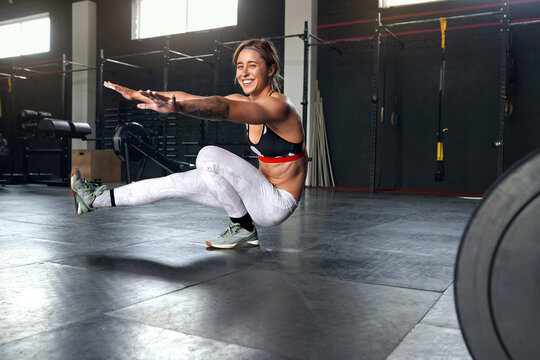
Pistol squats are considered the ultimate test of leg strength, requiring balance, coordination, and significant muscle power.
This single-leg squat engages multiple muscle groups, including the quadriceps, hamstrings, glute muscles, core, inner thighs, and calf muscles. To do a pistol squat correctly, you will need strong ankles and the ability to maintain stability on the standing leg.
How to:
- Stand on one leg, with your other leg extended straight in front of you, off the floor.
- Lower your body while keeping your extended leg straight.
- Descend as low as you can, maintaining balance and control, and keeping your core muscles tight.
- Press back up to the starting position using the strength of your standing leg.
For beginners, it’s advisable to start with progressions such as seated pistol squats or assisted versions using a support for balance. Don’t try to just jump into these without ever trying, or else you’ll probably end up falling on your butt. Trust me, I’ve been there.
Aim to perform 4 to 12 reps per side, with a rest period of 3 minutes between sets to allow for adequate recovery and maintain performance.
Cossack Squats
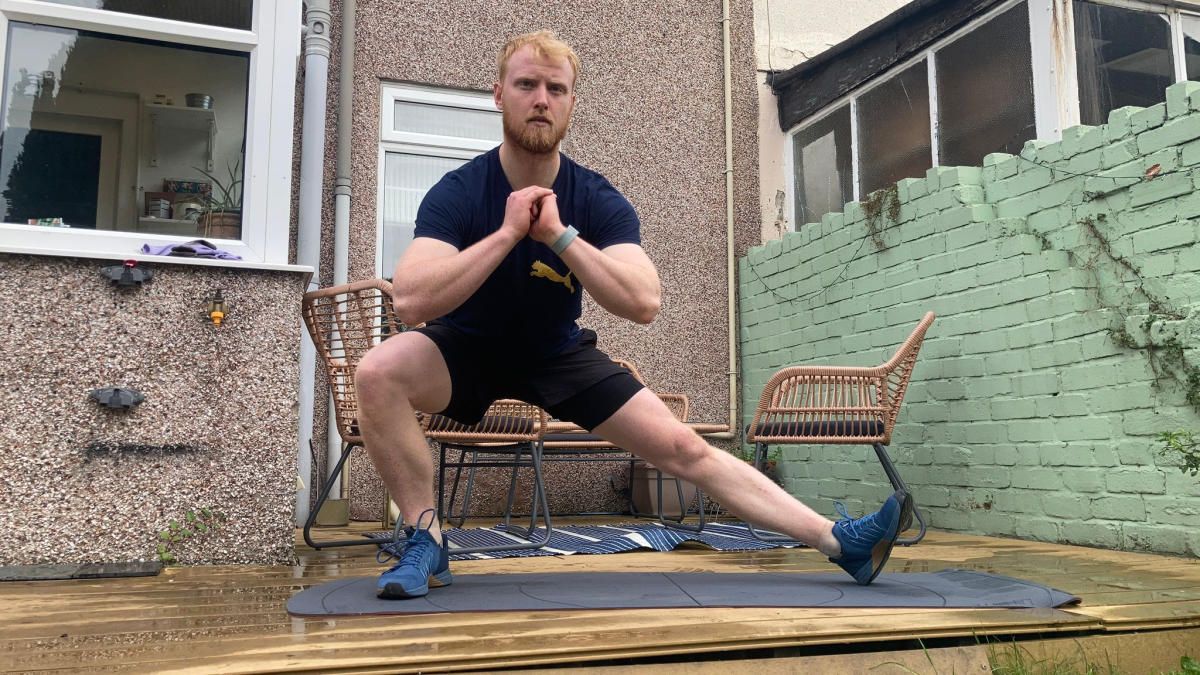
Cossack squats, also known as archer squats or lateral squats, focus on increasing intensity and improving hip and inner thigh mobility. This exercise has been great for me, as I sometimes struggle with hip mobility. It loosens up the hips and allows them to move better during other movements like the squat.
How to:
- Stand with your feet much wider than shoulder-width apart.
- Shift your weight to one side, bending one knee while keeping the other leg straight.
- Sink your hips down towards the foot of the bent leg while keeping your other leg straight with the foot flexed.
- Return to the center and repeat on the other side.
How to Structure Your Calisthenics Leg Workout
A well-structured calisthenics leg workout should include a warm-up, skill work, strength work, endurance/cardio, and a cool-down. Warming up prevents injuries and enhances performance during the workout. Effective warm-up exercises could include dynamic stretches and mobility drills to prepare your muscles and joints for the upcoming workout.
During the strength work phase, focus on proper form and consistency to maximize the benefits of your exercises. Incorporate a mix of compound and isolation exercises to target different muscle groups and build the leg as a whole. Aim for a rep range of 25 to 50 reps for muscle development, and consider using supersets to increase intensity and efficiency.
End your workout with a cool-down session that includes static stretching and rehabilitation exercises to help with muscle recovery and flexibility. Rest periods between sets are also very important for recovery and performance, typically ranging between 45 seconds to 3 minutes, depending on the intensity of the exercises. The higher the intensity, the longer rest needed.
Beginner Calisthenic Leg Workout

1. Bodyweight Squats
- Sets/Reps: 3 sets of 15 reps
- How to:
- Stand with feet shoulder-width apart.
- Keep your chest up and back straight as you bend your knees and lower your hips as if sitting in a chair.
- Lower down until your thighs are parallel to the ground, ensuring your knees don’t pass your toes.
- Push through your heels to stand back up to the starting position.
2. Lunges
- Sets/Reps: 3 sets of 12 reps per leg
- How to:
- Stand upright with feet together.
- Take a step forward with one leg, bending both knees to lower your hips.
- Drop your back knee toward the floor, keeping your front knee directly above the ankle.
- Push off your front foot to return to the starting position and switch legs.
3. Step-Ups
- Sets/Reps: 3 sets of 10 reps per leg
- How to:
- Find a step or a sturdy platform higher than knee level.
- Place one foot on the step, push through your heel to lift your body up, and step onto the platform.
- Step down with the same leg and repeat, then switch legs.
Intermediate Calisthenic Leg Workout
1. Jump Squats
- Sets/Reps: 4 sets of 12 reps
- How to:
- Perform a regular squat as described above.
- Explosively jump up from the bottom of the squat, extending your hips and swinging your arms for momentum.
- Land softly on your feet and go directly into another squat.
2. Bulgarian Split Squats
- Sets/Reps: 4 sets of 10 reps per leg
- How to:
- Stand a couple of feet from a bench or step, with your back to it.
- Extend one leg back and place the top of your foot on the bench.
- Squat down by flexing your knee and hip of your front leg until the knee of your rear leg is almost in contact with the floor.
- Push up through your front heel back to the starting position.
3. Walking Lunges
- Sets/Reps: 4 sets of 15 reps per leg
- How to:
- Stand with feet together and hands on your hips or by your sides for balance.
- Step forward with one leg into a lunge position.
- From the lunge, step forward with the other leg, transitioning into a lunge with the opposite leg.
- Continue moving forward with alternating lunges.
Advanced Calisthenic Leg Workout
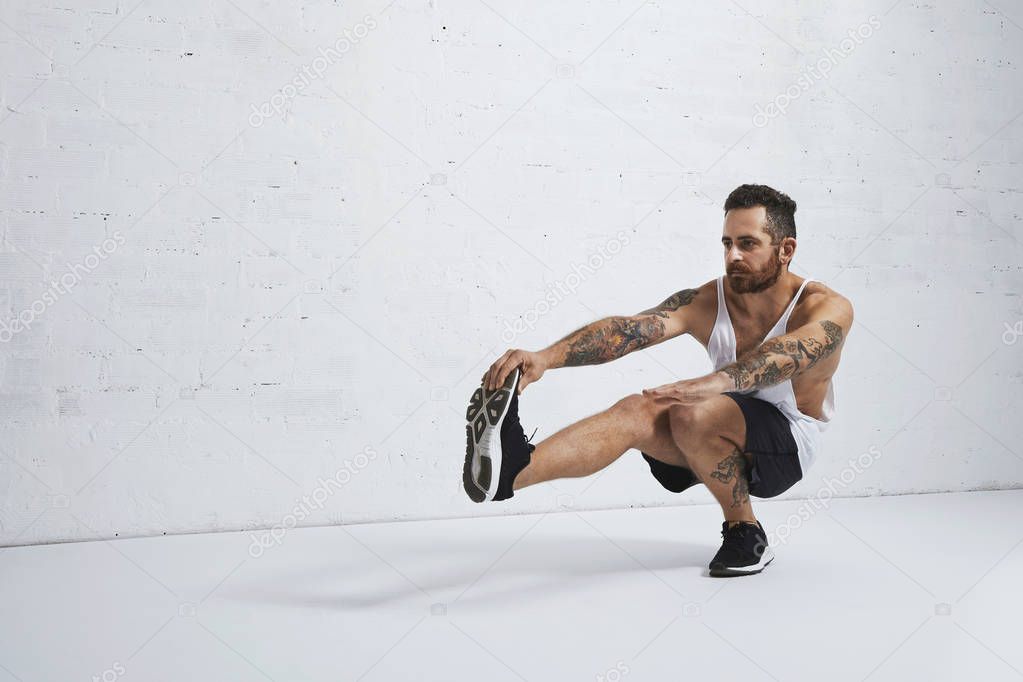
1. Pistol Squats
- Sets/Reps: 4 sets of 6 reps per leg
- How to:
- Stand holding your arms straight out in front of your body at shoulder level, parallel to the floor.
- Raise your right leg off the floor and hold it there.
- Flex your left knee, while your right leg remains straight, and lower your body as much as possible.
- Hold the position briefly, then push up to the starting position.
2. Single-leg Romanian Deadlifts
- Sets/Reps: 4 sets of 10 reps per leg
- How to:
- Stand on one leg, with the other leg slightly bent behind you.
- Lean forward, extending your free leg behind you for balance.
- Extend your arms and reach down toward your standing foot, keeping your back and extended leg straight.
- Push your hips forward to return to the upright position.
3. Broad Jumps
- Sets/Reps: 4 sets of 8 reps
- How to:
- Stand with your feet shoulder-width apart.
- Perform a deep squat then use your legs to explosively jump forward as far as possible.
- Land softly in a squat position and stabilize yourself.
- Stand and step back to the starting position and repeat.
These workouts progress in difficulty and intensity, offering options for beginners through advanced fitness pros. Adjust the reps and sets based on your current fitness level and goals.
Tips for Progressing in Calisthenics Leg Training
Progressing in calisthenics leg training involves continuously challenging yourself with more difficult exercises and variations. When an exercise becomes easy, consider incorporating isolation holds or increasing the intensity to provide a greater stimulus for muscle growth. These integrations will make for more challenging leg exercises.
Mixing up your routine by rearranging the order of exercises or increasing squat intensity can also help keep your workouts engaging and effective.
Avoid sticking to standardized beginner exercises for too long, as this can slow down your progress. Instead, try to perform harder progressions to keep advancing in your training.
Consistency and intensity are key to success in calisthenics leg training, so make sure to maintain a regular workout schedule and push yourself to near failure during your sets for maximum benefits.
Innovating your approach with new progressions and challenges will help you continually improve and achieve your fitness goals.
Remember, the ultimate goal in calisthenics is to perform more challenging exercises over time, so always strive to push your limits and exceed your previous achievements.
Importance of Rest and Recovery

Rest and recovery are key components of any successful calisthenics leg training program. Poor recovery habits, such as not getting enough sleep, will slow muscle growth and overall progress.
Make sure you get enough sleep, around 7-9 hours per night.
Proper nutrition, including getting enough protein intake, supports the repair and rebuilding of muscles after workouts. Try to get 30g of protein in as soon as you can after a workout.
Incorporating active recovery activities, such as gentle stretching or low-impact cardio, can enhance blood circulation and promote muscle healing. I love stretching and rolling out after a hard leg workout, so my muscles don’t tighten up on me too much.
Staying hydrated is also crucial, as water helps with maintaining muscle function and supports recovery processes. Drink tons of water before, during, and after the workout. The more you sweat, the more water you should drink.
Avoid overloading on exercises in a single session to prevent overtraining and burnout. Start slow and work your way there.
Common Mistakes in Calisthenics Leg Workouts

One common mistake in calisthenics leg workouts is not adhering to a structured training program, which can lead to ineffective workouts and limited progress. Lack of consistency in training can severely impact your results over time, so it’s important to maintain a regular workout schedule.
Additionally, choosing exercises that don’t align with your specific fitness goals will just slow your progress and effectiveness. So choose exercises that fit your goals! If you want to build your hamstrings for example, do some RDLs!
Frequent changes to workout routines can disrupt muscle memory and stunt overall progress. So it is crucial to stick to a consistent routine while gradually increasing intensity and complexity to ensure continuous improvement. Once the routine becomes monotonous, switch it up and shock the muscle.
Attempting advanced movements without foundational strength can lead to injuries and setbacks, so focus on building a solid base before progressing to more challenging exercises. Don’t just jump into pistol squats..
Undertraining by using too little intensity can prevent muscle growth and strength gains. Make sure to bring your sets close to failure and make sure you’re challenging yourself with each workout. If you feel like you could do another workout after you’re done, you’re not doing enough! You know if you are pushing yourself, so don’t cheat it!
Summary
Calisthenics leg workouts offer a versatile and effective way to build leg strength and muscle using just your body weight. These are amazing workouts you can do in the comfort of your own home, and are great ways to build yourself up before jumping into lifts with heavy weights.
By incorporating essential and advanced exercises, structuring your workouts properly, and focusing on progression, you can achieve impressive results before even grabbing a dumbbell or barbell!
Remember the importance of rest and recovery, and avoid common mistakes to maximize your gains. Embrace the challenge and transform your leg workouts with calisthenics for a stronger, more powerful lower body.







